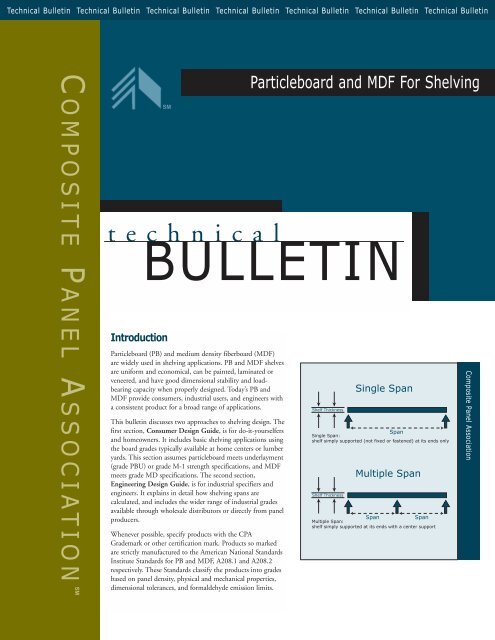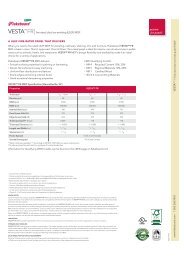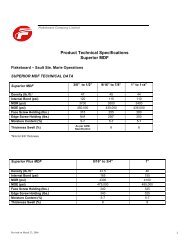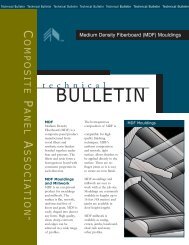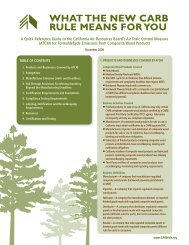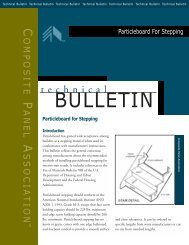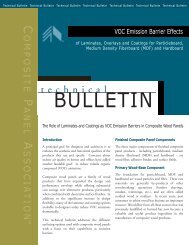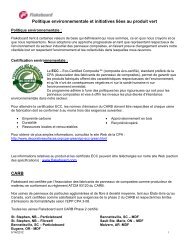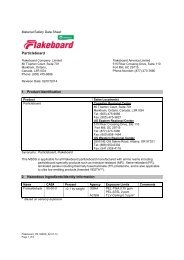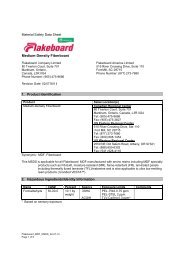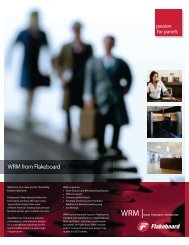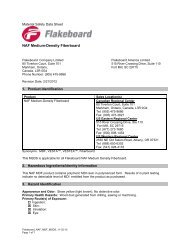Particleboard and MDF For Shelving - Composite Panel Association
Particleboard and MDF For Shelving - Composite Panel Association
Particleboard and MDF For Shelving - Composite Panel Association
Create successful ePaper yourself
Turn your PDF publications into a flip-book with our unique Google optimized e-Paper software.
Technical Bulletin Technical Bulletin Technical Bulletin Technical Bulletin Technical Bulletin Technical Bulletin Technical Bulletin<br />
C OMPOSITE P ANEL A SSOCIATION<br />
SM<br />
SM<br />
technical<br />
BULLETIN<br />
Introduction<br />
<strong>Particleboard</strong> (PB) <strong>and</strong> medium density fiberboard (<strong>MDF</strong>)<br />
are widely used in shelving applications. PB <strong>and</strong> <strong>MDF</strong> shelves<br />
are uniform <strong>and</strong> economical, can be painted, laminated or<br />
veneered, <strong>and</strong> have good dimensional stability <strong>and</strong> loadbearing<br />
capacity when properly designed. Today’s PB <strong>and</strong><br />
<strong>MDF</strong> provide consumers, industrial users, <strong>and</strong> engineers with<br />
a consistent product for a broad range of applications.<br />
This bulletin discusses two approaches to shelving design. The<br />
first section, Consumer Design Guide, is for do-it-yourselfers<br />
<strong>and</strong> homeowners. It includes basic shelving applications using<br />
the board grades typically available at home centers or lumber<br />
yards. This section assumes particleboard meets underlayment<br />
(grade PBU) or grade M-1 strength specifications, <strong>and</strong> <strong>MDF</strong><br />
meets grade MD specifications. The second section,<br />
Engineering Design Guide, is for industrial specifiers <strong>and</strong><br />
engineers. It explains in detail how shelving spans are<br />
calculated, <strong>and</strong> includes the wider range of industrial grades<br />
available through wholesale distributors or directly from panel<br />
producers.<br />
Whenever possible, specify products with the CPA<br />
Grademark or other certification mark. Products so marked<br />
are strictly manufactured to the American National St<strong>and</strong>ards<br />
Institute St<strong>and</strong>ards for PB <strong>and</strong> <strong>MDF</strong>, A208.1 <strong>and</strong> A208.2<br />
respectively. These St<strong>and</strong>ards classify the products into grades<br />
based on panel density, physical <strong>and</strong> mechanical properties,<br />
dimensional tolerances, <strong>and</strong> formaldehyde emission limits.<br />
<strong>Particleboard</strong> <strong>and</strong> <strong>MDF</strong> <strong>For</strong> <strong>Shelving</strong><br />
<strong>Composite</strong> <strong>Panel</strong> <strong>Association</strong>
Technical Bulletin Technical Bulletin Technical Bulletin Technical Bulletin Technical Bulletin Technical Bulletin Technical Bulletin<br />
Consumers Design Guide<br />
The information in this<br />
document is believed to be<br />
reliable <strong>and</strong> is intended to<br />
assist users of composite<br />
panel products. However,<br />
the determination of<br />
suitability of this<br />
information for a particular<br />
application remains the sole<br />
responsibility of the user.<br />
No guarantees,<br />
representations or express<br />
or implied warranties are<br />
made regarding the<br />
accuracy <strong>and</strong> completeness<br />
of this information, <strong>and</strong> the<br />
<strong>Composite</strong> <strong>Panel</strong><br />
<strong>Association</strong> (CPA) assumes<br />
no responsibility or liability<br />
for any loss or damage<br />
through reliance upon it.<br />
©<br />
Copyright 1998<br />
<strong>Composite</strong><br />
<strong>Panel</strong> <strong>Association</strong><br />
All rights reserved.<br />
Reproduction in whole<br />
or in part is prohibited<br />
without prior express<br />
written authorization<br />
from CPA.<br />
Consumers Design Guide:<br />
<strong>For</strong> Homeowners<br />
<strong>For</strong> many common shelving applications, use the table<br />
provided below. It is designed to quickly determine the<br />
amount of load that can be carried on either a PB or <strong>MDF</strong><br />
shelving system. It is important to underst<strong>and</strong> that the<br />
loads shown in the table are in units of pound per square<br />
foot (psf). This means that the load is evenly distributed<br />
over a one (1) square foot (144 square inches) area of shelf.<br />
The distribution area can be in any shape. <strong>For</strong> example, it<br />
can be 12 inches square, 8 by 18 inches, or any<br />
combination of dimensions that equals 144 square inches.<br />
Figure 1 gives common shelf nomenclature <strong>and</strong> displays<br />
some possible support<br />
situations.<br />
TABLE 1<br />
To use this table, first<br />
determine your estimated<br />
shelf loading, then select<br />
the desired combination<br />
of shelf span, product type<br />
<strong>and</strong> shelf thickness for<br />
your shelf design. The<br />
allowable spans are found<br />
directly across from the<br />
shelf load values. Spans<br />
are limited to a maximum<br />
of 36 inches.<br />
Shelf loads can vary<br />
greatly. <strong>For</strong> example,<br />
kitchen cabinet loads can<br />
reach up to 25 or 30 psf.,<br />
while bookshelf loads can<br />
easily reach 50 psf. It is<br />
necessary to know how<br />
much weight the shelf will<br />
be expected to carry. A<br />
simple bathroom scale<br />
may be used to estimate<br />
the anticipated load.<br />
When concentrated<br />
(heavy) loads are<br />
anticipated, it is<br />
important to note that the<br />
load acts only on the area<br />
where the object makes contact with the shelf. Concentrated<br />
loads can produce severe stress on shelves <strong>and</strong> must be<br />
considered carefully. Use the maximum concentrated load as<br />
the shelf loading value, rather than the average of all objects to<br />
be loaded on the shelf.<br />
The amount a shelf deflects (or bends) depends upon the load,<br />
shelf span, <strong>and</strong> panel thickness. Table 1 was designed to limit<br />
deflections to a percentage of the shelf span. <strong>For</strong> example, a<br />
shelf with a 24 inch span can be expected to deflect a<br />
maximum of 0.10 inches, while a 36 inch shelf span will<br />
deflect 0.15 inches (slightly more than 1/8").<br />
<strong>For</strong> shelves 12 inches or less in depth with continuous support along the back edge of the shelf,<br />
the allowable span can be doubled.<br />
A maximum overhang beyond bracket or support not to exceed 6 inches may be added<br />
to these spans.<br />
Single Span: shelf simply supported (not fixed or fastened) at its ends only. (see Figure 1)<br />
Multiple Span: shelf simply supported at its ends with a center support. Span lengths refer<br />
to the distance from support to support, not the total shelf length. (see Figure 1)<br />
psf. = pounds per square foot<br />
<strong>Composite</strong> <strong>Panel</strong> <strong>Association</strong>
Technical Bulletin Technical Bulletin Technical Bulletin Technical Bulletin Technical Bulletin Technical Bulletin Technical Bulletin<br />
Engineering Design Guide<br />
TABLE 2<br />
Engineering Design Guide:<br />
<strong>For</strong> Specifiers <strong>and</strong> Engineers<br />
This section contains additional detail to provide<br />
the shelf designer with an underst<strong>and</strong>ing of the<br />
engineering basis used in common designs. It<br />
also allows for more refined calculations <strong>and</strong><br />
flexibility in the design process for those familiar<br />
with structural design equations.<br />
Span Tables<br />
<strong>For</strong> most applications the spans shown in Tables<br />
2 <strong>and</strong> 3 will suffice. As with any span table there<br />
are assumptions built into the calculations.<br />
These assumptions are described below.<br />
• Based on the variability associated with<br />
industrial production, the published ANSI<br />
st<strong>and</strong>ard strength <strong>and</strong> stiffness values (MOR<br />
<strong>and</strong> MOE) for PB <strong>and</strong> <strong>MDF</strong> were reduced by<br />
20 percent.<br />
• To minimize long term deflection, an<br />
allowable shelf deflection limit of span/240<br />
was used. This minimizes the stress in the<br />
shelf. <strong>For</strong> example, a 32-inch shelf span would<br />
be designed for a total instantaneous<br />
deflection of 0.13 inches when a load<br />
distributed uniformly over the entire surface,<br />
is applied. Long term deflection is often<br />
considered to be twice the short term<br />
deflection for design purposes.<br />
• Due to the wide variety of techniques to<br />
fasten the shelf into the frame of a shelf<br />
system, all supports were considered pinned<br />
(simple) in these analyses. No increase in span<br />
was considered for semi-rigid end fixed<br />
conditions.<br />
• Spans were limited to a maximum of 48<br />
inches.<br />
Design equations for other loading <strong>and</strong> support<br />
conditions are discussed later.<br />
TABLE 3<br />
<strong>For</strong> shelves 12 inches or less in depth with continuous support along the back edge of the shelf,<br />
the allowable span can be doubled.<br />
A maximum overhang beyond bracket or support not to exceed 6 inches may be added<br />
to these spans.<br />
Single Span: shelf simply supported (not fixed or fastened) at its ends only. (see Figure 1)<br />
psf. = pounds per square foot.<br />
<strong>For</strong> shelves 12 inches or less in depth with continuous support along the back edge of the shelf,<br />
the allowable span can be doubled.<br />
A maximum overhang beyond bracket or support not to exceed 6 inches may be added<br />
to these spans.<br />
Multiple Span: shelf simply supported at its ends with a center support. Span lengths refer<br />
to the distance from support to support, not the total shelf length. (see Figure 1)<br />
psf. = pounds per square foot.<br />
<strong>Composite</strong> <strong>Panel</strong> <strong>Association</strong><br />
<strong>Composite</strong> <strong>Panel</strong> <strong>Association</strong>
Technical Bulletin Technical Bulletin Technical Bulletin Technical Bulletin Technical Bulletin Technical Bulletin Technical Bulletin<br />
Engineering Design Guide<br />
Engineering Design Equations<br />
The previous information may not be adequate for some residential or industrial applications.<br />
Where other deflection limits, load, or span conditions are desired, the following equations are<br />
applicable. Actual design should be left to a trained professional. An underst<strong>and</strong>ing of basic<br />
engineering design principles is assumed, <strong>and</strong> the determination of suitability of this<br />
information is the sole responsibility of the user.<br />
Physical/mechanical property values published in the ANSI st<strong>and</strong>ards are shown in Table 4 <strong>and</strong><br />
represent average properties. They do not include safety factors, <strong>and</strong> it is the responsibility of<br />
the designer to determine safety factors or other reduction factors commensurate with their<br />
particular application. The following equations use loading values expressed in pounds per<br />
square inch (psi), while the span tables on the proceeding pages use loading values expressed in<br />
pounds per square foot (psf). These equations are from the Timber Construction Manual, 4th<br />
Edition, 1994, courtesy of the American Institute of Timber Construction.<br />
TABLE 4<br />
“Loading that is not<br />
symmetrically<br />
positioned on a shelf<br />
can cause<br />
exaggerated<br />
moments in a shelf<br />
panel, particularly<br />
when several loads<br />
are placed on the<br />
same shelf.”<br />
Physical/Mechanical Property Values for <strong>Particleboard</strong> <strong>and</strong> Medium Density Fiberboard<br />
Modulus of Rupture (MOR) Modulus of Elasticity (MOE)<br />
*<br />
* ANSI A208.1-1993<br />
** ANSI A208.2-1994<br />
<strong>Composite</strong> <strong>Panel</strong> <strong>Association</strong>
Technical Bulletin Technical Bulletin Technical Bulletin Technical Bulletin Technical Bulletin Technical Bulletin Technical Bulletin<br />
Engineering Design Guide<br />
Single Span (Simple Support) Condition<br />
Uniform load<br />
Uniform load partially distributed<br />
Concentrated load at any point
Technical Bulletin Technical Bulletin Technical Bulletin Technical Bulletin Technical Bulletin Technical Bulletin Technical Bulletin<br />
Engineering Design Guide<br />
Two unequal concentrated loads unsymmetrically placed<br />
Multiple Span (Multi-Support) Condition<br />
“Shelf loads can<br />
vary greatly. <strong>For</strong><br />
example, kitchen<br />
Two equal spans with concentrated loads at any point<br />
cabinet loads can<br />
reach up to 25 or<br />
30 psf., while<br />
bookshelf loads<br />
can easily<br />
reach 50 psf.”
Technical Bulletin Technical Bulletin Technical Bulletin Technical Bulletin Technical Bulletin Technical Bulletin Technical Bulletin<br />
Engineering Design Guide<br />
Concentrated load at center with variable end<br />
moments<br />
Other Considerations<br />
Two equal spans with uniform load on both spans<br />
Overhang Condition<br />
<strong>For</strong> purposes of engineering design, it will be assumed that the<br />
overhanging ends of a shelf system induce a moment in the<br />
primary span (l). This moment depends upon the size of the<br />
overhang <strong>and</strong> the weight on it.<br />
Adjustment Factors - Adjustment factors can take the form<br />
of reductions in the allowable design values to compensate<br />
for potential overload situations or creep deflection. Creep<br />
refers to the phenomenon of shelf deflection that<br />
accumulates over time under sustained loading. <strong>For</strong> most<br />
wood composites, creep can be exaggerated by high or<br />
fluctuating humidity conditions. Often a designer will<br />
assume creep deflections to be equal to or greater than the<br />
initial elastic deflection <strong>and</strong> design accordingly.<br />
Unsymmetric Loading - Loading that is not symmetrically<br />
positioned on a shelf can cause exaggerated moments in a<br />
shelf panel, particularly when several loads are placed on<br />
the same shelf. The effect can be compounded when shelf<br />
overhangs are part of the design. The designer is cautioned<br />
to use the appropriate design equation when considering<br />
such load applications. When overhangs are considered,<br />
the equations shown above are useful to calculate the<br />
maximum bending moment.<br />
Uniformly distributed load with variable end moments<br />
Concentrated Load Considerations - Concentrated loads<br />
typically cause stresses in excess of uniform loads of equal<br />
magnitude. However, most loads are neither concentrated<br />
at a point or uniformly distributed across the shelf area.<br />
Therefore, when designing shelving systems it is usually<br />
more prudent to design for concentrated loads than<br />
uniform loads. <strong>For</strong> complicated concentrated load<br />
situations, the law of superposition can be applied.<br />
Actual Loads - Shelf loads vary greatly. <strong>For</strong> example,<br />
kitchen cabinet loads can reach up to 25 or 30 psf., while<br />
bookshelf loads can easily reach 50 psf. It is necessary to<br />
know how much weight the shelf will be expected to carry.<br />
A simple bathroom scale may be used to estimate the<br />
anticipated load levels.<br />
Metric Conversion Values<br />
1ft = 0.3048 m<br />
1m = 3.281 ft.<br />
1ft 2 = 0.0929 m 2<br />
1m 2 = 10.76 ft 2<br />
1lb/ft 2 = 4.882 kg/m 2<br />
1kg/m 2 = 0.2048 lb/ft 2
Technical Bulletin Technical Bulletin Technical Bulletin Technical Bulletin Technical Bulletin Technical Bulletin Technical Bulletin<br />
What is the <strong>Composite</strong> <strong>Panel</strong> <strong>Association</strong><br />
References<br />
1997-1998 Buyers <strong>and</strong> Specifiers Guide to North American <strong>Particleboard</strong> <strong>and</strong> <strong>MDF</strong> Manufacturers <strong>and</strong> Products,<br />
<strong>Composite</strong> <strong>Panel</strong> <strong>Association</strong>, Gaithersburg, MD.<br />
ANSI A208.1-1993 <strong>Particleboard</strong>, American National St<strong>and</strong>ard, <strong>Composite</strong> <strong>Panel</strong> <strong>Association</strong>, Gaithersburg, MD.<br />
ANSI A208.2-1994 Medium Density Fiberboard, American National St<strong>and</strong>ard, <strong>Composite</strong> <strong>Panel</strong> <strong>Association</strong>,<br />
Gaithersburg, MD.<br />
Medium Density Fiberboard From Start to Finish, <strong>Composite</strong> <strong>Panel</strong> <strong>Association</strong>, Gaithersburg, MD, 1998.<br />
<strong>Particleboard</strong> From Start to Finish, <strong>Composite</strong> <strong>Panel</strong> <strong>Association</strong>, Gaithersburg, MD, 1996.<br />
Timber Construction Manual, 4th Edition, 1994, American Institute of Timber Construction,<br />
Englewood, Colorado.<br />
The <strong>Composite</strong> <strong>Panel</strong><br />
<strong>Association</strong> (CPA) is the North<br />
American trade association for<br />
the particleboard (PB) <strong>and</strong> the<br />
medium density fiberboard<br />
(<strong>MDF</strong>) industries, <strong>and</strong> for other<br />
compatible products. The CPA<br />
is dedicated to increasing the<br />
acceptance <strong>and</strong> use of industry<br />
products <strong>and</strong> educating users<br />
about the benefits of these<br />
products.<br />
Membership in the CPA<br />
currently includes 34 of the<br />
leading U.S. <strong>and</strong> Canadian<br />
manufacturers of industry<br />
products. Together, they<br />
represent more than 85 percent<br />
of total North American<br />
manufacturing capacity of these<br />
products.<br />
CPA Member Companies<br />
Allegheny <strong>MDF</strong> LP<br />
Allegheny <strong>Particleboard</strong> LP<br />
Boise Cascade Corporation<br />
CanPar Industries<br />
Collins Products, LLC<br />
Columbia <strong>For</strong>est Products<br />
Del-Tin Fiber, LLC<br />
Flakeboard Company Ltd.<br />
Florida Plywoods, Inc<br />
Georgia-Pacific Corporation<br />
Hambro <strong>For</strong>est Products, Inc.<br />
Isobord Enterprises, Inc.<br />
Langboard, Inc.<br />
Louisiana-Pacific Corporation<br />
MacMillan Bloedel Ltd.<br />
Merillat Industries, Inc.<br />
Norbord Industries, Inc.<br />
Northern Engineered Wood<br />
Products, Inc.<br />
Panolam Industries<br />
Pan Pacific Products, Inc.<br />
Plum Creek Timber Company LP<br />
Potlatch Corporation<br />
Proboard Ltd.<br />
<strong>Composite</strong> <strong>Panel</strong> <strong>Association</strong> SM<br />
<strong>Association</strong> des fabricants de panneaux de composites<br />
SM<br />
Rexwood Products (1996) Ltd.<br />
SierraPine Ltd.<br />
Tafisa Canada <strong>and</strong> Company Ltd.<br />
Temple<br />
Timber Products Company<br />
Uniboard Canada, Inc.<br />
Union Camp Corporation<br />
Webb Furniture Enterprises, Inc.<br />
West Fraser Mills<br />
Weyerhaeuser Company<br />
Willamette Industries, Inc.<br />
The <strong>Composite</strong> <strong>Panel</strong> <strong>Association</strong><br />
was formed in 1997 as a<br />
consolidation of the National<br />
<strong>Particleboard</strong> <strong>Association</strong> <strong>and</strong><br />
the Canadian <strong>Particleboard</strong><br />
<strong>Association</strong>. The CPA represents<br />
industry on technical,<br />
regulatory, quality assurance<br />
<strong>and</strong> product acceptance issues.<br />
An affiliated organization, the<br />
<strong>Composite</strong> Wood Council, was<br />
formed in 1989 to broaden<br />
participation in industry<br />
educational <strong>and</strong> promotional<br />
programs. Membership in the<br />
<strong>Composite</strong> Wood Council is<br />
highly diverse <strong>and</strong> includes<br />
more than 175 companies<br />
worldwide, including all<br />
members of the <strong>Composite</strong><br />
<strong>Panel</strong> <strong>Association</strong>. Programs <strong>and</strong><br />
activities of the CPA <strong>and</strong> the<br />
Council complement each other.<br />
18928 Premiere Court • Gaithersburg, Maryl<strong>and</strong>, USA 20879<br />
Tel 301/670-0604 • Fax 301/840-1252 • www.pbmdf.com<br />
4612 Saint Catherine St. West • Westmount, Quebec H3Z 1S3<br />
Tel 514/989-1002 • Fax 514/989-9318<br />
11/98 2.5k


